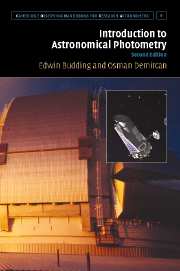Book contents
- Frontmatter
- Contents
- Preface to first edition
- Preface to second edition
- 1 Overview
- 2 Introduction
- 3 Underlying essentials
- 4 Themes of astronomical photometry
- 5 Practicalities
- 6 Procedures
- 7 Basic light curve analysis
- 8 Period changes in variable stars
- 9 Close binary systems
- 10 Spotted stars
- 11 Pulsating stars
- Appendix
- Author index
- Subject index
2 - Introduction
Published online by Cambridge University Press: 13 August 2009
- Frontmatter
- Contents
- Preface to first edition
- Preface to second edition
- 1 Overview
- 2 Introduction
- 3 Underlying essentials
- 4 Themes of astronomical photometry
- 5 Practicalities
- 6 Procedures
- 7 Basic light curve analysis
- 8 Period changes in variable stars
- 9 Close binary systems
- 10 Spotted stars
- 11 Pulsating stars
- Appendix
- Author index
- Subject index
Summary
Optical photometry
Astronomical photometry is about the measurement of the brightness of radiating objects in the sky. We will deal mainly with optical photometry, which centres around a region of the electromagnetic spectrum to which the human eye (Figure 2.1) is sensitive. Indeed, photometric science, as it concerns stars, has developed out of a history of effort, the greatest proportion of which, over time at least, has amounted to direct visual scanning and comparison of the brightness of stellar images. In this context, brightness derives from an integrated product of the eye's response and the energy distribution as it arrives from the celestial source to reach the observer. Still today there is a large amount of monitoring of the many known variable stars carried out (largely by amateurs) in this way.
With the passage of time, however, there has been a general trend towards more objective methods of measurement. The use of photometers with a non-human detector element has become increasingly widespread, though the term optical remains to denote the relevant spectral range (Figure 2.2), which significantly coincides with an important atmospheric ‘window’ through which external radiation can easily pass. This is presumably connected with biological evolution: in fact, the maximum sensitivity of the human eye is at a wavelength close to the maximum in the energy versus wavelength distribution of the Sun's output (∽5000 Å).
- Type
- Chapter
- Information
- Introduction to Astronomical Photometry , pp. 11 - 38Publisher: Cambridge University PressPrint publication year: 2007



